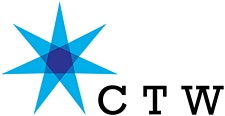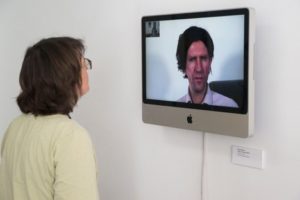Interview by Kelly Olshan

Biography
Richard Jochum is a conceptual artist working in a broad variety of media with a strong focus on video, installation, and performance. A recent creative resident of Harvestworks T.E.A.M. Lab, he is currently a studio member at the Elizabeth Foundation of the Arts and an associate professor of art and art education at Teachers College, Columbia University. Jochum received his PhD from the University of Vienna (1997) and an MFA in sculpture and media art from the University of Applied Arts in Vienna (2001). His work has been exhibited widely. His art practice is accompanied by research into artistic research practices, studio art teaching and learning, as well as new media and media art education. Jochum coordinates the Creative Technologies Certificate as part of the Art and Art Education Program.
You have a background in philosophy, theology, and political science. How did you end up in the sphere of art education?
I had a tremendous appetite for academic subjects when I entered post-secondary education. But after working through several disciplines I didn’t just want to become a specialist theoretician adding to the proliferation of books. Instead, I found my calling as an artist, which seemed to me like a formidable way to translate some of the heavy stuff I had read into practice. I found the arts to be different from academia, broader, and more inclusive. I still remember when I entered art school and how it felt like “homecoming”. The arts allowed me to express myself. But, ultimately, for me art is dialogical.
How do you navigate your dual roles as both an educator and an artist? Do your skill sets as an academic influence your creative practice, and vice versa?
I believe strongly in the synergy between being an artist and working in education. The art world can at times be very hung up with itself; artists are naturally inclined to monologue. While this inherent narcissism of artistry becomes more problematic in a world of social media in which all of us compete for attention, I see teaching as a remedy. It creates a balance. Being a teacher is about care and student needs.
In addition, students can learn from their teachers being artists. The synergy between art and education has many a layer. I often encourage students to conceptualize their work, develop a reflective framework, and place it carefully within a context, a context which needs to be understood. To draw from our intellectual capacities is not just an addition to the work of art; it’s mandatory. We don’t just operate in studios any more, even if we still use them. With the disappearance of the studio as a traditional space we enter an arena of the political, the societal, the cultural in a way we haven’t seen it before. Making art also means making culture. This is an important lesson for students to understand.
What was the impetus for designing the Creative Technologies Certificate (CTC) program?
As an artist-teacher who works in the field of new media, I see how technology leaves no stone unturned. That applies to an increasing level of interactivity through electronic media. The field of art education has changed so profoundly that it became necessary for us to adapt the curriculum and radically expand our offerings to our students who sometimes feel at a loss when it comes to using technology in their art making. As a matter of fact, to a degree we all feel at a loss. The Creative Technologies Certificate was a way to tackle this and incorporate digital fabrication, programming, physical computing, electronics, a swath of new materials, and emerging technologies at the intersection of art, technology, and sciences.
What are some of the challenges associated with getting students comfortable with utilizing technology in the classroom?
That’s a question that I think a lot about. I noticed that artists tend to be a little more comfortable trying out new things than art educators. Artists often gain by being the first to incorporate a novel approach. What do they really have to lose? Art history – often for lack of better criteria – constantly lauds artists who were “firsts”. It can be tremendously hip to work with the newest gadgets and serve as an example: look at that! That’s cool. It’s different for art educators. Art educators tend to waver when it comes to teaching others what they are just barely learning themselves. They rarely have enough time in the studio and sometimes don’t have enough confidence in their own work. And tinkering is not something that the regular school curriculum allows for. The challenge is not only to give future art educators studio time, but also to change the pedagogies and make them feel comfortable—fluent—with emerging technologies. Art teachers have to understand that they don’t have to be experts when it comes to technology. They have to learn that nobody really is enough of an expert. Once we learn to see that working with technology is based on collaboration and shared expertise, then we can trust that the learning doesn’t just come from the teacher, but from the students as well, and that teachers are in fact co-learners.
How do you think creative technologies are changing institutions of higher education? What is your advice—for educators, students, and administrators—in navigating these changes?
There has been much talk lately about a second gilded age. I agree that the scale of upheaval necessitates strong metaphors. While we are all very affected by the technological changes around us, nobody really has the recipe and we are only slowly learning to deal with these upheavals. One of the characteristics of the technology around us is that it enhances and accelerates our communicative potential; but it also throws us off balance. Higher education is affected across the board. We are all struggling to reinvent teaching and learning, getting used to new pedagogies of collaboration, team learning and shared expertise. From my point of view, we can best tackle these changes by being creators. Media art education helps us to re-approach technology creatively.
What’s so cool about your upcoming symposium?
The upcoming symposium on June 18 deals with exactly these questions and focuses on the theme of collaboration. I am very excited to see our students taking a leading role in organizing the symposium. Symposium “Modes of Collaboration” Teachers College, Columbia University. RSVP: goo.gl/VK6hZc
More information: ctc.tc.columbia.edu

